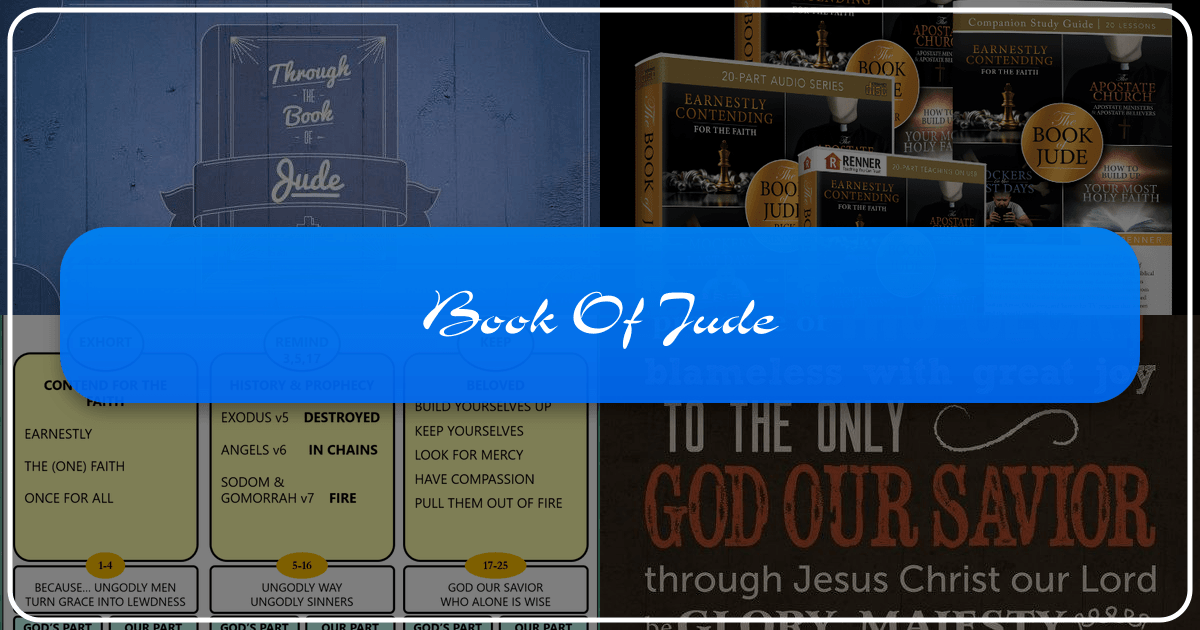The Book of Jude: A Deeper Dive into a Neglected Epistle

The Book of Jude, a relatively short yet powerfully impactful epistle in the New Testament, often receives less attention than its longer counterparts. However, its concise yet potent message on maintaining faith amidst encroaching heresy remains profoundly relevant today. This in-depth exploration delves into the Book of Jude, examining its historical context, theological themes, and enduring significance, structured to align with various aspects of a comprehensive book-related website.
I. Book of Jude: Literary Context and Authorship
The Book of Jude, attributed to Jude, the brother of James, presents itself as a personal letter rather than a formal treatise. This intimate style enhances its immediacy and impact. The identification of Jude as a “servant of Jesus Christ and brother of James” (Jude 1:1) immediately establishes his credentials and humility. While his familial relationship to Jesus could have been a claim to authority, Jude chooses to emphasize his servitude to Christ, thereby prioritizing spiritual lineage over bloodline. This suggests a conscious move towards emphasizing the new covenant established through Christ’s teachings and sacrifice.
The dating of the Book of Jude remains a topic of scholarly discussion, but many scholars place its composition around AD 65-80. This period is significant as it falls within the tumultuous years following the death of the apostles, marking a time when early Christianity was wrestling with internal challenges. Jude’s letter’s urgent tone reflects the imminent threat of false teachers undermining the foundations of the faith. The intertextual relationships between Jude and 2 Peter further suggest a chronological proximity, though the precise relationship – whether mutual borrowing, independent compilation from a shared source, or direct influence – remains a subject of ongoing debate among biblical scholars. Detailed analysis of the shared vocabulary and thematic structures, along with potential common sources from Jewish apocryphal literature like 1 Enoch, provides valuable insights into the literary context and possible historical connections.

A. Genre and Classification:
The Book of Jude falls within the genre of “epistolary literature,” essentially a letter written to a specific audience for a particular purpose. However, it also incorporates elements of other literary forms:
- Apostolic Letter: It shares characteristics with other New Testament letters, exhibiting concern for its recipients and expressing a sense of pastoral responsibility.
- Apocalyptic Literature: Jude utilizes apocalyptic imagery and rhetoric, drawing heavily on Old Testament prophetic and wisdom traditions to emphasize the severity of the impending threat of false teachers. This apocalyptic influence underscores the urgency of the letter’s message, presenting the struggle against heresy not simply as a matter of doctrinal correction but as a cosmic battle between good and evil.
- Sermon: The letter’s structure and content, including vivid descriptions of apostasy and its consequences, suggest that it functioned almost as a sermon or public address, meant to be read aloud to the intended community.
II. The Book of Jude: Theological Themes and Arguments
The central theme of Jude is the urgent call to contend earnestly for the faith (Jude 1:3). This contention is not mere intellectual debate; it is a resolute struggle for the preservation and purity of the gospel. The author’s concern stems from the infiltration of “ungodly people” who pervert God’s grace into a license for immorality and deny the Lordship of Jesus Christ (Jude 1:4).
A. The Nature of Faith and Apostasy:
Jude defines “the faith” as the gospel message originally entrusted to the saints, a once-for-all delivery that is not subject to revision or addition (Jude 1:3). This emphasis on the unchanging core of the Christian faith contrasts sharply with the false teachings introduced by the heretics. Apostasy, according to Jude, manifests in several ways: ungodliness, licentiousness, and denial of Christ’s Lordship. This progression reveals the insidious nature of heresy, starting subtly with a departure from godly conduct and escalating to a complete rejection of Jesus. By employing numerous Old Testament and extra-biblical examples, Jude highlights that this deviation is not a new phenomenon. The consequences of such apostasy are graphically described, underscoring their profound seriousness.

B. Examples of Judgment and Warning:
Jude employs several historical examples—the destruction of unbelieving Israel, the fall of angels, and the fate of Sodom and Gomorrah—to illustrate the consequences of rejecting God’s grace and authority. These examples serve as cautionary tales for his recipients, emphasizing that such judgments are not arbitrary acts of divine wrath but the natural outcome of defying God’s commands. The inclusion of extra-biblical texts, particularly from 1 Enoch, demonstrates the broad range of sources Jude draws upon to convey his warning. The use of these varied literary sources emphasizes the continuity between the Old Testament and New Testament understandings of God’s judgment.

C. Exhortations and Encouragements:
Despite the severity of his warning, Jude does not end on a note of despair. He offers practical exhortations to the faithful, emphasizing the importance of building up one’s most holy faith through prayer in the Holy Spirit (Jude 1:20). The faithful are encouraged to remain steadfast in God’s love, awaiting the mercy that leads to eternal life (Jude 1:21). Further, Jude encourages mercy toward those who doubt while actively rescuing others from the clutches of false teachings (Jude 1:22-23). This combination of warning and encouragement reveals the author’s deep pastoral concern for the well-being of the community. The letter concludes with a powerful doxology, affirming God’s power and glory, emphasizing the steadfastness of God’s grace despite the challenges of heresy.
III. The Book of Jude: Cultural Impact and Legacy
The Book of Jude, despite its brevity, has exerted a significant influence on Christian thought and practice. Its warnings against false teachers have resonated throughout church history, serving as a constant reminder of the need to uphold orthodox doctrine and maintain ethical integrity. The letter’s use of vivid imagery and strong rhetoric has inspired many preachers and theologians, demonstrating the power of concise, impactful communication.
A. Theological and Ethical Influence:
The theological themes of the Book of Jude, including the importance of upholding orthodox doctrine, maintaining ethical integrity, and demonstrating compassion towards those who are struggling, have shaped theological discussions and ethical guidelines within Christianity. Its warnings against false teachers have continued to influence the way churches approach heresy and maintain doctrinal purity. The ethical framework of Jude, which calls for both firmness in the faith and mercy toward those who are faltering, has been highly influential in church discipline and the approach to internal conflict within Christian communities.
B. Literary and Artistic Adaptations:
The Book of Jude’s themes of judgment, warning, and steadfast faith have inspired various artistic interpretations throughout history. The imagery and narrative elements in Jude have been adapted to various art forms and creative expressions, both visual and literary. Such interpretations often focus on the letter’s warnings, the imagery of judgment, and the need for the faithful to remain strong in their faith. These works show Jude’s continued relevance as a source of inspiration for religious art, literature, and sermons.
C. Jude and the Modern Church:
The Book of Jude’s message remains strikingly relevant in the modern church. In an age of ever-increasing information and conflicting ideologies, the need to discern truth from falsehood is paramount. The letter’s warnings against false teachers and its call to contend for the faith offer a timely reminder of the ongoing battle between truth and error within the Church.
IV. Exploring Resources on the Book of Jude
A variety of resources can further illuminate the intricacies of the Book of Jude:
- Commentaries: Numerous commentaries delve deeply into the theological nuances, historical context, and literary style of the book. These commentaries offer varying perspectives and insights, deepening understanding of the text.
- Bible Studies: Many Bible studies focus on the Book of Jude, offering practical applications of its message for modern believers. These studies often provide discussion questions and group activities to facilitate learning and engagement.
- Online Resources: Websites dedicated to biblical study, theology, and apologetics offer articles, essays, and other resources that provide a broader understanding of the letter’s significance. These online resources offer diverse perspectives and access to scholarly work.
- Scholarly Articles: Journal articles, essays, and academic books offer advanced analysis of the text and its cultural context, furthering academic exploration of Jude’s message and influence.
By engaging with these diverse resources, readers can gain a richer and more nuanced understanding of this frequently overlooked, yet profoundly significant, book of the Bible. The message of Jude is not merely a historical artifact but a timeless call to faithfulness, reminding us to stand firm in the truth and to contend earnestly for the faith once delivered to the saints. The enduring power of Jude’s words continues to resonate with Christians today.